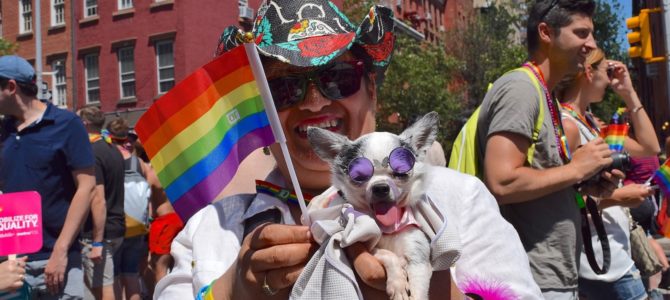
Every year, GLAAD, the organization that advocates for LGBT acceptance in society, conducts a study called the Accelerating Acceptance Index. This national survey takes the country’s temperature about what used to be known as gay and lesbian rights and straight people’s acceptance of them.
While the first three years of the study showed an increase in social acceptance, last year’s study showed a sharp decrease. After a big push by GLAAD during the ensuing year, the results remained mostly stable but did not return to the higher levels of acceptance of previous years.
It was primarily the younger folks surveyed who were responsible for the drop-off. The question is how could this have happened? In this 50th anniversary year of the Stonewall riots, what’s up with the kids?
The survey asks in-depth questions not only about feelings about LGBT individuals and practices, but scenarios involving them as well. Questions concerning comfort levels with LGBT family members, friends, teachers, and peers, as well as academic lessons on LGBT history and social awareness, showed that the group of 18- to 34-year-olds felt the most uncomfortable.
It’s a fascinating turn about, since all previous generations, from boomers to millennials, exhibited an increase in acceptance of LGBT interactions each year. The upshot of all this is that there was a plunge from 63 percent acceptance in 2016 to 45 percent in 2018.
Why the Change in Attitude?
Respondents to the survey were asked about their comfort level with LGBT-identified people in a variety of situations. These included: “learning a family member is LGBTQ,” with 36 percent responding that such a thing would make them “very uncomfortable”; a question about finding out that one’s child is “placed in a class with an LGBTQ teacher,” to which 33 percent said they were “very uncomfortable”; and “learning my child had a lesson on LGBTQ history in their school,” to which 39 percent responded with “very uncomfortable.” A question that wasn’t asked was whether the discomfort was due to the person, or the assumed politics of those individuals.
In the past several years there have been fights over forcing bakeries to make cakes for gay weddings, states opening women’s prisons to male-bodied people, drag shows featuring children, schools interfering between children and parents to establish a child’s trans identity, the emergence of the term “cis” to define the rest of us whether we like it or not, the increasing number of gender identities and the accompanying demands that they be respected or else, the entire pronoun thing, the politicization of rainbows, all the flags and how we’re supposed to know what they all mean, and the takedown of beloved children’s authors as anti-LGBT based solely on their Twitter follows.
Perhaps the LGBTQIAP+ contingent has reached a saturation point in culture and society at large is ready to not think about sexuality all the time. In Manhattan, for example, there were two Pride marches on June 30 in New York. The Reclaim Pride Coalition is offended, like traditional Christians at Christmastime, by the consumerism of the Pride parade. They organized the Queer Liberation March, without police presence or corporate sponsors, to retain the grassroots feel of the original movement.
The NYC Pride parade began as a protest march after Stonewall, and this year has rebranded as the World Pride Parade. Pride and equal rights are so mainstreamed that hundreds of companies offer corporate sponsorships, and there’s nothing wrong with that. It’s a net positive that people are free to live and love as they choose.
The Reclaim Pride Coalition may be right about the negative effects of so much corporatization. This new rollout of “pronoun packs” from Oreo was bound to elicit massive amounts of eye rolling. Was Oreo really saying their classic cookie wasn’t for everyone? Do we need to establish our sexuality and gender identity with every pre-packaged cookie we eat? How did we get to the point where shoving our identifiers into everyone’s face was considered even reasonably polite?
Sephora launched the “identify as we” ad campaign, which definitely has a hivemind ring. Budweiser distributed various LGBT pride flag cups, each for a super-specific identity more obscure than the last. Even Manhattan Mini Storage rolled out a new rainbow logo because storage wasn’t inclusive enough of everything and everyone already.
Pride Is a Good Thing; Being Pushy Isn’t
Pride is a good thing, as nondiscrimination and equal rights are essential for the successful functioning of our civil society. But the overtaking of the Pride movement by the trans agenda really didn’t help matters, and even lots of lesbians want to get the L out.
Believing in total equality for same-sex attracted persons, their right to employment, to marry, to have those unions recognized across state lines, to adopt children and raise families, requires very little imagination from the average straight person. The prior iteration of the gay rights movement did a great job in making the case that same-sex attracted people are not deviants, but simply people who are attracted to members of their own sex as opposed to the opposite one. People got on board. It really didn’t seem like a big deal.
Asking society at large to believe that biological sex is mutable, on the other hand, demands the kind of mental gymnastics or willful ignorance that is mostly found in PhD-level philosophy programs. When you go from “Will & Grace” to Drag Queen Story Hour, you’re gonna lose the kids along the way. LGBTQIAP+ culture is pushing so hard that it’s pushing the kids off the edge.
Giving an interview to Time Magazine, GLAAD President Sarah Kate Ellis said she believes the increase in intolerance from youth is due to a need for more education about LGBT issues. This indicates she isn’t taking to heart the results of the study. Given how much awareness and education is out there for kids about alternative gender and sexual lifestyles — more than ever before — you’d be hard pressed to find an 18- to 34-year-old who didn’t have loads of understanding about the issues.
‘Kids [today] are dealing directly with this generation of people that define sexual orientation and gender identity so broadly,’ Ellis says. ‘They’re finding this newness a little bit confusing…We are absolutely at an inflection point where culture and policy is stalled right now,’ Ellis concludes. ‘Closing the gap to full acceptance of LGBTQ people will not come from legislation on judicial decisions alone, but from creating a culture where LGBTQ people are embraced and respected.’
What she’s missing is that these are not new issues to the 18- to 34-year-old set. Just as they are a generation of tech natives, they are natives in identity politics, the LGBT identity spectrum among them.
If they are feeling uncomfortable about the plethora of gender identities, the crazed concept that biological sex can be changed through surgeries, hormones, and wishes, and just think everyone should live their lives according to their own desires and not impose speech requirements on everyone, they are not wrong. It would do the LGBT movement well to take a step back from total cultural saturation of their cause, and remember that respect for equal rights, and wanting to remember 30,000 different pronouns and to whom they are applied, are completely separate things.









